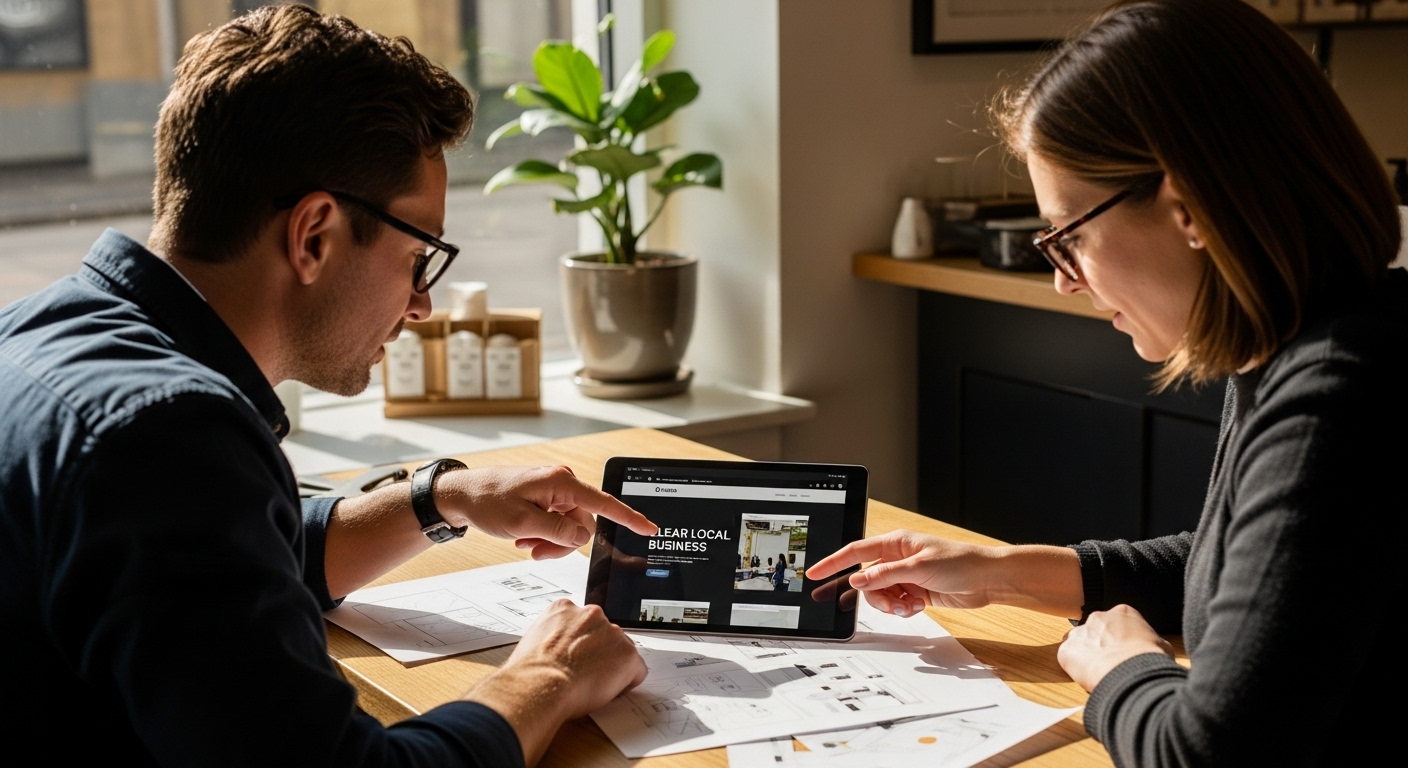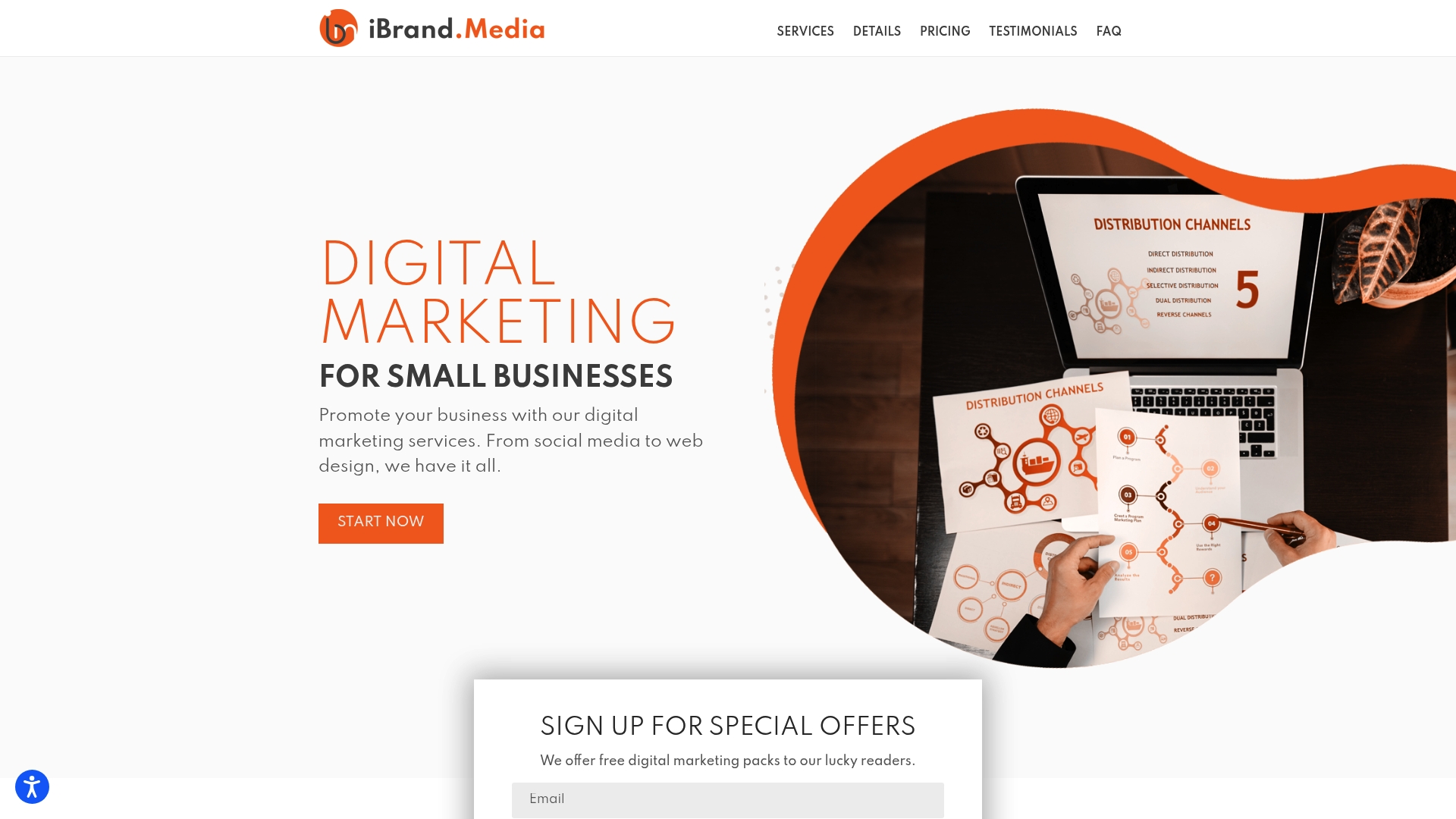Website design often sounds like picking some colors and uploading a logo. But nearly 75 percent of users admit they judge a business’s credibility based purely on its website design. Most people think it is all about making things look pretty online. The real story is that design shapes trust, drives sales, and can make or break any local business long before a customer even walks through your door.
Table of Contents
- What Is Website Design And Why It Matters
- Key Principles Of Effective Website Design
- Understanding User Experience In Web Design
- The Role Of Mobile Responsiveness In Website Design
- How Visual Elements Influence Website Engagement
Quick Summary
| Takeaway | Explanation |
|---|---|
| Website design enhances business credibility. | A well-designed website signifies professionalism, helping local businesses attract and retain customers effectively. |
| User experience must prioritize intuitive navigation. | Simplified navigation ensures users can easily find information, improving engagement and satisfaction significantly. |
| Mobile responsiveness is essential for all devices. | Websites must adapt seamlessly to various devices to maintain user engagement and prevent losing potential customers. |
| Visual design influences user perception immediately. | Strategic use of colors, images, and layout creates an emotional connection, enhancing user trust and interest in products. |
| Calls-to-action must be strategically placed. | Well-positioned calls-to-action guide users toward desired actions, improving conversion rates and overall effectiveness of the site. |
What is Website Design and Why It Matters
Website design represents the comprehensive process of conceptualizing, planning, and creating digital experiences that communicate a business’s brand, services, and value proposition through visual and interactive elements. For local businesses, website design transcends mere aesthetics—it functions as a critical digital storefront that can attract, engage, and convert potential customers.
The Fundamental Components of Website Design
Effective website design integrates multiple strategic elements that work together to create a compelling online presence.
The following table breaks down and defines the fundamental components of effective website design as discussed in the article.
| Component | Definition |
|---|---|
| Visual Design | Determines website appearance using color schemes, typography, imagery, and layout to express brand. |
| User Experience (UX) | Focuses on how easily and pleasantly visitors navigate and interact with the site. |
| Information Architecture | Organizes and structures website content logically for intuitive discovery. |
| Technical Functionality | Encompasses the website’s underlying technology, performance, and responsiveness. |
![]() Visual design determines how your website looks, using color schemes, typography, imagery, and layout to communicate your brand’s personality. User experience focuses on how easily visitors can navigate and interact with your website, ensuring intuitive pathways and seamless interactions.
Visual design determines how your website looks, using color schemes, typography, imagery, and layout to communicate your brand’s personality. User experience focuses on how easily visitors can navigate and interact with your website, ensuring intuitive pathways and seamless interactions.
According to Nielsen Norman Group, website usability directly influences user perception and engagement. A well-designed website can significantly impact a local business’s ability to attract and retain customers by creating a professional, trustworthy digital environment.
Why Professional Website Design Matters for Local Businesses
Local businesses operate in a competitive digital landscape where first impressions are crucial. Your website often serves as the initial touchpoint for potential customers, making its design a critical factor in establishing credibility and encouraging customer interaction. A professionally designed website communicates several key signals:
- Demonstrates business legitimacy and professionalism
- Provides clear, accessible information about products and services
- Creates an intuitive user experience that reduces customer friction
If you want to learn more about converting website visitors into leads, check out our comprehensive guide on website lead generation. Professional website design is not just about looking good—it’s about creating a strategic digital tool that supports your business growth and connects with your target audience effectively.
Key Principles of Effective Website Design
Website design for local businesses requires a strategic approach that balances aesthetic appeal with functional excellence. Successful website design goes beyond visual presentation, focusing on creating digital experiences that effectively communicate brand value and facilitate user interactions.
User-Centered Design Principles
The cornerstone of effective website design is prioritizing user experience. This means creating intuitive navigation, ensuring content is easily accessible, and designing interfaces that guide visitors seamlessly toward their desired actions.
User-centered design considers the specific needs, preferences, and behaviors of your target audience, transforming your website from a simple online presence into a powerful business tool.
According to University of Washington, effective website design should maintain consistency in elements like text size, color, fonts, and layout across all pages. This consistency helps users feel comfortable and reduces cognitive load, making it easier for potential customers to understand and engage with your content.
Critical Design Elements for Local Business Websites
Successful website design incorporates several fundamental elements that work together to create a compelling digital experience:
- Clear and compelling visual hierarchy
- Responsive design that adapts to different devices
- Fast loading times and smooth performance
- Intuitive navigation and user journey
- Strategic placement of calls-to-action
To ensure your website performs optimally across all platforms, learn more about website speed optimization. Remember that a well-designed website is not just about looking professional—it’s about creating a digital environment that converts visitors into customers by providing a seamless, engaging experience.
This table summarizes the five key principles of effective website design for local businesses, highlighting their core focus and impact.
| Principle | Core Focus | Impact |
|---|---|---|
| Visual Hierarchy | Organizes elements for attention | Guides user focus to important content and actions |
| Responsive Design | Adapts to devices and screen sizes | Provides seamless experience on desktops and mobile devices |
| Fast Loading Times | Minimizes delays in content appearance | Reduces user frustration and site abandonment |
| Intuitive Navigation | Simplifies site structure and movement | Enhances engagement and helps users find information |
| Strategic Calls-to-Action | Guides users to desired interactions | Increases conversions and tracks user engagement |
Understanding User Experience in Web Design
User experience (UX) in web design represents a holistic approach to creating digital interfaces that are not just visually appealing, but fundamentally functional and engaging for visitors. For local businesses, UX design transforms websites from static information platforms into dynamic, interactive tools that effectively guide potential customers through their decision-making journey.
The Core Elements of User Experience
User experience goes far beyond aesthetic design, encompassing how easily and pleasantly users can interact with a website. It involves understanding user behaviors, anticipating their needs, and creating digital pathways that feel intuitive and natural. This means designing interfaces that are simple to navigate, quick to load, and immediately comprehensible.
According to Nielsen Norman Group, user experience integrates multiple dimensions of interaction, including usability, accessibility, and emotional response. A well-crafted UX design considers how users perceive and move through digital spaces, ensuring that every interaction feels smooth and purposeful.
Key UX Considerations for Local Business Websites
Effective user experience design for local businesses requires strategic attention to several critical components:
- Intuitive navigation that helps users find information quickly
- Clear, concise content that communicates value immediately
- Responsive design that works seamlessly across devices
- Fast loading times that prevent user frustration
- Strategically placed calls-to-action that guide user journeys
To maximize your website’s potential, explore our comprehensive guide to optimizing websites for search. Remember that exceptional user experience is not about creating the most complex website, but about designing a digital environment that feels effortless, welcoming, and aligned with your customers’ needs and expectations.
The Role of Mobile Responsiveness in Website Design
Mobile responsiveness represents a critical design strategy that ensures websites function effectively across diverse devices and screen sizes. For local businesses, this approach is no longer optional but essential—it directly impacts user engagement, search engine rankings, and overall digital marketing success.
Understanding Mobile Responsive Design
Mobile responsive design dynamically adjusts website layout, content, and functionality to provide an optimal viewing experience regardless of device. This means your website automatically reconfigures its design elements—text, images, navigation menus—to look and work perfectly whether someone visits from a smartphone, tablet, or desktop computer. Responsive design eliminates the need for separate mobile and desktop websites, creating a seamless user experience that adapts to each user’s specific device.
According to Proceedings of the International Conference on Human-Computer Interaction, responsive web design significantly mitigates potential engagement losses by maintaining consistent access across different platforms. This approach ensures that local businesses can reach and retain customers regardless of their preferred device.
Critical Mobile Responsiveness Considerations
Effective mobile responsive design involves several key strategic elements that local businesses must prioritize:
- Fluid grid layouts that automatically resize
- Flexible image and media scaling
- Touch-friendly navigation elements
- Readable text without manual zooming
- Rapid loading times across network conditions
Learn more about optimizing website speed for small businesses, which is crucial for maintaining mobile user engagement. Mobile responsiveness is not just a technical requirement—it’s a fundamental approach to creating inclusive, accessible digital experiences that meet your customers exactly where they are.
How Visual Elements Influence Website Engagement
Visual elements are the silent communicators of your website, instantly conveying your brand’s personality, professionalism, and value proposition. For local businesses, strategic visual design goes beyond aesthetic appeal—it creates an emotional connection that can transform casual visitors into engaged customers.
The Psychology of Visual Design
Visual design operates on multiple psychological levels, influencing user perception and behavior within seconds of landing on a webpage. Color psychology, typography, imagery, and layout work together to create an intuitive narrative that guides users through their digital experience. Professional visual design communicates credibility, evokes specific emotions, and establishes an immediate sense of trust with potential customers.
According to PLOS ONE research, visual complexity and design prototypicality significantly impact users’ first impressions. Simple, clean designs that align with users’ expectations can create more positive initial reactions, increasing the likelihood of continued engagement.
Strategic Visual Elements for Local Business Websites
Effective visual design incorporates several critical components that enhance user engagement and communication:
- Consistent color palette reflecting brand identity
- High-quality, relevant imagery
- Clean, readable typography
- Strategic white space for visual breathing room
- Intuitive visual hierarchies that guide user attention
Discover strategies to boost website traffic and understand how visual design plays a crucial role in attracting and retaining potential customers. Remember that visual elements are not just decorative—they are powerful communication tools that can significantly influence user perception and behavior.

Ready to Make Your First Online Impression Count?
Many local businesses struggle to create a website that actually attracts and converts new customers. From the article, you know how vital it is to have a professional digital storefront — from intuitive user experience to mobile responsiveness and strong visual design. If your business website feels outdated or hard to use, you risk missing out on valuable leads who judge your credibility in seconds.
Explore how our tailored solutions can solve those pain points on our Uncategorized | Ibrandmedia category page.

Stop losing customers to first impressions that fall flat. Visit ibrand.media to discover how you can build a website that works as hard as you do. Start a custom website project or discuss your digital marketing plan with our experts today. The right design can make all the difference in your business growth — act now and get ahead of your competition.
Frequently Asked Questions
What are the key components of effective website design for local businesses?
Effective website design for local businesses includes visual design, user experience (UX), information architecture, and technical functionality, which work together to create a compelling online presence.
How does user experience impact website engagement?
A positive user experience improves website usability, making it easier for visitors to navigate and interact with your site, thus increasing engagement and the likelihood of conversions.
Why is mobile responsiveness important in website design?
Mobile responsiveness ensures that websites function effectively on various devices and screen sizes, enhancing user engagement and accessibility, making it essential for local businesses.
What role do visual elements play in website design?
Visual elements communicate your brand’s personality and professionalism, influencing user perception and behavior, and can significantly enhance user engagement and trust.
Recommended
- How to Optimize Website Speed: Faster Sites for Small Businesses 2025 | Ibrandmedia
- Top SEO Techniques for Small Business Owners in 2025 | Ibrandmedia
- Creating a Brand for Small Businesses: A 2025 Step-by-Step Guide | Ibrandmedia
- Optimizing Websites for Search: A Guide for Small Businesses 2025 | Ibrandmedia

Recent Comments